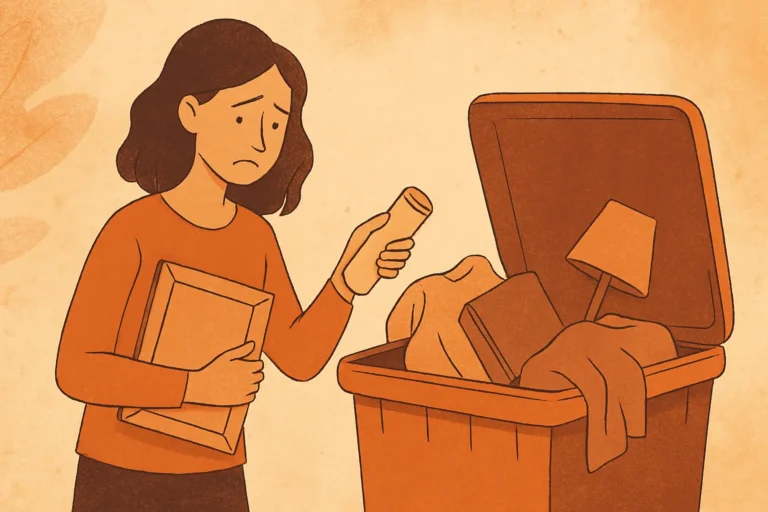The Hidden Emotions Behind Hoarding: Guilt, Fear, and Control
Hoarding isn’t just about clutter. It’s about emotions we don’t always see or understand—like guilt, fear, and control.
So what really causes someone to hoard?
At its core, hoarding is often a way people deal with deeper emotions they don’t know how to face. It’s not just about keeping stuff—it’s about what that stuff represents.
Let’s break down the emotional layers behind hoarding and understand why it’s so hard to let go.
Hoarding Isn’t Laziness—It’s Emotional
Some people think hoarding happens because someone is lazy or messy. But that’s not true. Many hoarders feel deep emotional pain every time they try to throw something out.
For them, each item may feel like a piece of their identity, their memories, or even their safety net.
That’s why cleaning up a hoarder’s home without understanding these emotions can backfire. They’re not just losing “junk”—they’re losing something that means much more to them inside.
Guilt: “What if I Need It Later?”
Guilt is one of the strongest emotions tied to hoarding. You might hear hoarders say things like:
- “I spent money on it. I can’t just throw it away.”
- “Someone gave this to me.”
- “What if I need it someday?”
This guilt makes it almost impossible to let go. Even if the item hasn’t been used in years, the idea of throwing it away triggers feelings of wastefulness or disrespect.
Many people were raised with the message: “Don’t waste.” That message gets stuck in their head and turns into guilt every time they try to declutter.
Fear: “Letting Go Feels Unsafe”
Fear is another powerful force behind hoarding. It shows up in many ways.
Some fear they’ll forget important memories if they get rid of objects. Others fear something bad will happen if they don’t keep a certain item “just in case.”
For example, someone might keep every bill they’ve ever received out of fear that they’ll be audited—even if it’s been 20 years.
Fear makes people over-prepare, over-save, and over-collect. In the moment, keeping everything feels safer than risking regret.
Control: “This Is the One Thing I Can Decide”
For some hoarders, their world feels chaotic—either now or in the past. Maybe they had a traumatic childhood, lost a job, or dealt with abusive relationships.
In these cases, hoarding can feel like the only area of life they can control.
They get to decide what stays and what goes. No one else can tell them what to do with their things.
So, when someone comes in and starts throwing things away, it can feel like a personal attack. Like they’re losing control all over again.
Why It’s So Hard to Ask for Help
Because hoarding is tied to such deep emotions, many people feel ashamed to talk about it.
They might hide their home from family and friends. They might avoid having people over. Some even isolate themselves entirely.
It becomes a cycle: the more they hoard, the more shame they feel—and the more they hide. That hiding only makes the emotional clutter grow.
When “Stuff” Becomes a Substitute for Love or Safety
For some people, physical objects are more than just items—they’re comfort.
A stack of old newspapers might remind them of a time when life felt stable. A pile of broken toys might feel like the only link to a lost child.
Letting go of these things feels like letting go of a part of themselves. That’s why even small cleanups can trigger strong emotional reactions—like panic, sadness, or anger.
What You Can Do If You Struggle with Hoarding
If you relate to this, first of all—you’re not alone. And you’re not broken.
Start small. Pick one drawer. Or even one item. Ask yourself, “What emotion does this bring up for me?”
Don’t try to force yourself to declutter overnight. Focus more on why you’re keeping something than what you’re keeping.
Journaling can help. So can therapy, especially with someone trained in hoarding or trauma.
Helping a Loved One Who Hoards
If someone you care about struggles with hoarding, patience is key. Forcing them to throw things away usually makes things worse.
Instead, talk to them. Ask them what certain items mean to them. Understand the emotion behind the item before you suggest parting with it.
Offer support, not judgment. Celebrate small wins, like when they clear one surface or throw out a few old items.
Sometimes, progress is just being willing to talk about the problem.
Don’t Underestimate Emotional Clutter
Just like physical clutter builds up in a room, emotional clutter builds up in the mind.
Guilt, fear, and a need for control don’t go away on their own. They need to be faced gently, one layer at a time.
It’s not about getting rid of stuff—it’s about making peace with your past and feeling safe in your present.
There’s Always a Way Forward
Hoarding isn’t the end of the road. Many people have worked through it—slowly, patiently, with help.
The first step is not throwing things out. It’s being kind to yourself and recognizing that the clutter is just a symptom. The real healing begins when you understand the emotions underneath.
Once those emotions are seen and cared for, the need to hoard often starts to fade.
Final Thoughts
Hoarding is never just about “stuff.” It’s about unspoken pain, unresolved fears, and a deep need for comfort or safety.
Understanding the hidden emotions—guilt, fear, and control—can turn judgment into compassion, and chaos into healing.
If you’re facing this yourself or know someone who is, remember: you don’t have to fix everything in one day. Start with kindness. That’s the first thing worth holding on to.

